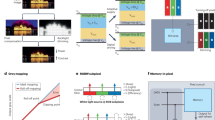Abstract
This paper introduces a hardware system for user-centric display energy management. From the camera readings, the system detects the user presence and gaze and produces signals that control the display backlight. Experiments show that the system operates in real-time, has 88% detection accuracy and consumes less than 1W of power.
Preview
Unable to display preview. Download preview PDF.
Similar content being viewed by others
References
Robertson, J., Homan, G.K., Mahajan, A., et al.: Energy use and power levels in new monitors and personal computers. LBNL-48581, UC Berkeley (July 2002)
Mahesri, A., Vardhan, V.: Power Consumption Breakdown on a Modern Laptop. In: Falsafi, B., VijayKumar, T.N. (eds.) PACS 2004. LNCS, vol. 3471, pp. 165–180. Springer, Heidelberg (2005)
Advanced Configuration and Power Interface Specification, Rev.3.0 (September 2004), http://www.acpi.info/spec.htm
Energy savings with personal computers, Fujitsu-Siemens Corp., http://www.fujitsu-siemens.nl/aboutus/sor/energysaving/profdesk_prod.html
2006 Global Citizenship Report, Hewlett-Packard Co., http://www.hp.com/hpinfo/globalcitizenship/gcreport/pdf/hp2006gcreport_lowres.pdf
Method for laptop mouse pad user-presence detection, http://priorartdatabase.com/IPCOM/000009803/
Park, W.I.: Power saving in a portable computer, EU Patern, EP0949557 (1999)
Dai, X., Ravichandran, K.: Computer screen power management through detection of user presence, US Patent 6650322, November 18 (2003)
Moshnyaga, V.G., Morikawa, E.: LCD Display Energy Reduction by User Monitoring. In: Proc. Int. Conf. on Computer Design (ICCD), pp. 4–97 (2005)
Kawato, S., Tetsutani, N., Osaka, K.: Scale-adaptive face detection and tracking in real time with SSR filters and support vector machine. IEICE Trans.Information & Systems E88-D(12), 2857–2863 (2005)
Moshnyaga, V.G., Yamamoto, S.: Algorithm Optimizations for Low-Complexity Eye-Tracking. In: Proc. IEEE Int.Conf. of Systems, Man & Cybernetics (2009)
Kawato, S., Ohya, J.: Two-step approach for real-time eye-tracking with a new filtering technique. In: IEEE Int. Conf. of Systems, Man & Cybernetics, pp. 1366–1371 (2000)
Author information
Authors and Affiliations
Editor information
Editors and Affiliations
Rights and permissions
Copyright information
© 2010 Springer-Verlag Berlin Heidelberg
About this paper
Cite this paper
Moshnyaga, V.G., Hashimoto, K., Suetsugu, T., Higashi, S. (2010). A Hardware Implementation of the User-Centric Display Energy Management. In: Monteiro, J., van Leuken, R. (eds) Integrated Circuit and System Design. Power and Timing Modeling, Optimization and Simulation. PATMOS 2009. Lecture Notes in Computer Science, vol 5953. Springer, Berlin, Heidelberg. https://doi.org/10.1007/978-3-642-11802-9_10
Download citation
DOI: https://doi.org/10.1007/978-3-642-11802-9_10
Publisher Name: Springer, Berlin, Heidelberg
Print ISBN: 978-3-642-11801-2
Online ISBN: 978-3-642-11802-9
eBook Packages: Computer ScienceComputer Science (R0)




